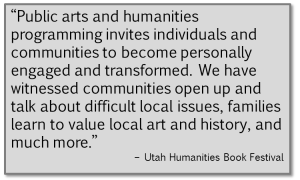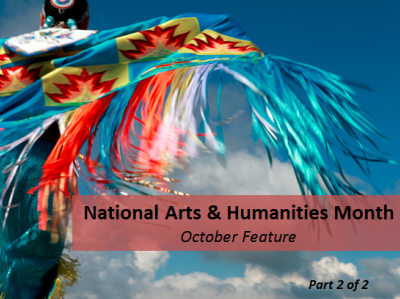ENGAGE, EXPLORE, ENCOURAGE, EDUCATE, EXPERIENCE
It’s National Arts and Humanities Month!
(Part 2 of 2)
On September 28, President Obama declared October as National Arts & Humanities month. To celebrate the two important disciplines, the Federation has been highlighting council programs that  blend both the arts and humanities to address topics of national and community importance. Last week’s column highlighted programs that engaged communities in revitalization efforts, encouraged conversations on difficult topics such as race and the environment, and explored cultural traditions and their place in contemporary culture. This week, we feature programs that enable participants to experience, in new ways, the stories that stitch the nation together.
blend both the arts and humanities to address topics of national and community importance. Last week’s column highlighted programs that engaged communities in revitalization efforts, encouraged conversations on difficult topics such as race and the environment, and explored cultural traditions and their place in contemporary culture. This week, we feature programs that enable participants to experience, in new ways, the stories that stitch the nation together.
ENCOURAGE – Students and Underserved Populations
In Nebraska, the council is using the universal language of music to inspire and serve small rural communities through its support of Hear Nebraska’s Good Living Tour, a statewide concert series that brings a mix of free, original Nebraska bands and DJs to communities that rarely have the opportunity to host live music. Prior to the concert series, a team of professional journalists and videographers visited communities in search of compelling, music-related stories. One such story involved Nathan Olson, aka DJ Pink Bunny, who grew up in Grant, NE (pop. 1,137), where the only way to learn guitar was through the Internet, and who is now a musician on the tour.
California Humanities also explored the importance of arts and humanities programming in encouraging youth with the final installment of their On the Road with California Humanities series, “In Tune: The Arts and Humanities in the Golden State.” The event featured artist and educator Marc Bamuthi Joseph in conversation with Pulitzer Prize finalist Morton Subotnick and was bookended by youth performances.
Additionally, both Colorado Humanities and Arizona Humanities couple the two disciplines in programs designed to encourage creativity and conversation, while providing historical context. In the series, “The American West as Living Space: Pulitzer Readings and Conversations,” Colorado Humanities conducted writing workshops with high schools around the state and hosted conversations using Pulitzer Prize-recognized authors of the American West. This fall, the Arizona council brought internationally renowned cultural leaders Bocafloja and Mark Gonzales to the state in a series of programs that used storytelling, poetry, and film to learn about people whose “lives were defined by their ability to negotiate identity and racial consciousness” and to explore the “healing of trauma influenced by social and political contexts.” In addition to public performances, Bocafloja and Gonzales conducted workshops for university and high school students, and female inmates at the Perryville Prison.
EDUCATE – Understanding Others’ Experiences and Our Own
Many councils are also using the arts to educate conversations on other’s experiences. One such program is the Wisconsin Humanities Council-supported exhibition, “My War: Wartime Photographs by Vietnam Veterans,” at the Highground Learning Center and operated by the Wisconsin Vietnam Veterans Memorial Project. Featuring more than 70 personal photographs from Wisconsin Vietnam Veterans depicting their war experiences, the exhibit organizes the photos by subject, interspersing personal letters and context about the war experience. Described as “visual poetry,” the exhibit has helped veterans better process and share their experiences. As Steve Maddox, Vietnam War Veteran and photo contributor, stated “Here’s the permission to remember everything you want to remember. ‘My War’ invites you to step back in your mind.” Highground Learning Center coordinator June Berg Abrahamson stated that “to dig out their photos and share a part of their lives with family and friends that most have kept hidden away for 50 years was… a challenge.” She added that the “process brought back smiles, tears, fears, and memories many had long ago buried deep in their minds” and that “through this process [veterans] also found a sense of freedom and release, and that family and friends ‘really did care and want to know’ about their service.”
The Delaware Humanities Forum, in partnership with Art of Remembrance, has also created an exhibition that provokes important conversations on the war experience through the work of Esther Nisenthal Krinitz, who has depicted her story of survival from the Holocaust through a series of 36 fabric collage and embroidery panels. The exhibit permits participants to experience the story of a young girl who details her account of war through art and bears witness to scenes of tragedy and trauma, juxtaposed with the beauty of natural surroundings.
Another exhibition seeking to spark conversation and understanding is the Wyoming Humanities Council-supported art exhibition, “The Bridge,” which featured nearly 50 contemporary visual artists of Arab, Jewish, Persian, Muslim, and Christian backgrounds who focused on commonality through their cultures and creeds. The exhibit was on display in four cities simultaneously with numerous programming events including musical performances, panel discussions, and presentations to move people closer to “a better understanding and peace between religions by overcoming stereotypes, apprehensions, biases, and misunderstandings.” The exhibit brought together a wide variety of organizations with the combined goal of making this difficult topic approachable. “I, also, am enormously grateful for all the work done to accomplish what we had hoped – rich programming to accompany a world-class art exhibit about the qualities within us all that will lead us to greater understanding of each other, and ultimately, peace on earth,” said Press Stephens, Foundation for the Episcopal Diocese of Wyoming.
In a very different approach to exploring cultural identity, the Wisconsin Humanities Council supported the Museum of Wisconsin Art exhibition, “Art on Tap,” which encouraged residents of Wisconsin to discover, and rediscover, elements of their collective nostalgia using brands created more than one hundred and fifty years ago and linking those brands to historic and contemporary culture. Reborn multiple times in different markets among immigrants, housewives, workingmen, and hipsters, iconic beer brands Pabst, Blatz, Schlitz, and Miller have “a staying power and romantic appeal unrivaled in the history of consumer culture.” The exhibition highlights these leaders of brand identity and how “they took generic commodities and turned them into social symbols and distinctive markers that still endure today.”
EXPERIENCE – Connecting People
Several other council programs blend the arts and humanities to connect people across different interests. For instance, in Virginia, the council brings together a community of artists exploring books, paper, and printmaking through its Virginia Arts of the Book Center (VABC), a hands-on studio that engages in arts and humanities projects with a community-access approach. As VABC member artist Kristin Adolfson said, “I’m constantly surprised and impressed with the amazing work that comes out of the shop… these projects offer artists an opportunity to get out of their comfort zone. What results are dynamic, fascinating projects as well as a deeper community among artists.” In North Carolina, the council seeks to bring scholars and community members together at local libraries to discuss issues of local interest. Among the many discussion series within this program is, “Looking at Jazz: America’s Art Form,” which explores the cultural and social history of jazz as it developed into an art form. According to the 2016 site project director, “it was a great blend of music, innovation, politics, society, and culture of the time – the good, the bad, and the ugly… Several audience members stated to me that this series got them interested in jazz music – which they had never listened to in the past.” Also in North Carolina, the council’s Road Scholars program includes more than 70 speakers whose lectures often fall at the intersection of the arts and humanities.
Councils also host events in partnership with arts and cultural organizations to bring together artists and humanists and to celebrate noteworthy contributors such as Indiana Humanities’ “TILT: An Arts and Humanities Mixer” designed in partnership with the Arts Council of Indianapolis to engage attendees in reinventing the traditional lecture followed by a “quirky and highly participatory Q&A.” Or, like the Utah Humanities’ annual Utah Humanities Book Festival and the Alaska Humanities Forum’s Governor’s Award for the Arts and Humanities, which encourages the public to nominate award recipients, bringing increased knowledge, awareness, and recognition of the contributions of the arts and humanities in every day Alaskan life.
Additionally, councils serve as resources to their communities in order to inspire individuals in community-led workshops, such as the Delaware Humanities Forum creative writing workshops, or to help organizations like the Michigan Humanities Council’s “Arts and Humanities Touring Program,” a joint collaboration between the council and Michigan Council for Arts & Cultural Affairs that features more than 100 offerings representing the state’s “most talented performing and visual artists and humanities presenters” for organizations seeking to conduct their own programming. Both the North Carolina Humanities Council and Utah Humanities, as do many other councils, also offer quick and mini grants to support relevant programming.
Be sure to check out your state humanities council to determine what events or resources they offer in your community, or check out the program finder to sort programs by areas of interest.


